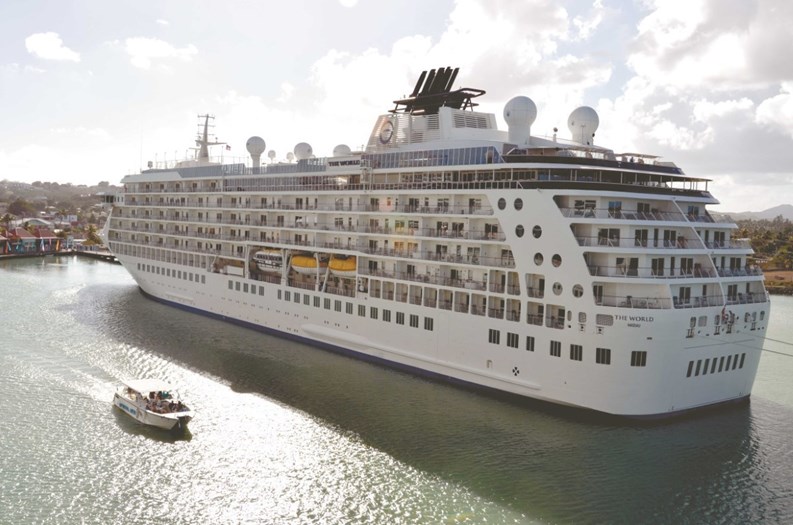When most people think of a buying and owning a co-op or condo apartment, they're picturing a unit in a mid- or high-rise building, or possibly a townhome in a suburban development. While that's certainly the most typical format for apartment ownership, it's hardly the only one. As the economy has shifted and globalization has enabled more and more people to communicate and work from nearly anywhere in the world, new models of ownership have emerged and evolved that just a decade or so ago would have been impossible—or at least very impractical.
Consider the Caltons, for example. For seven years, Mira Calton and her husband, Dr. Jayson Calton owned one of the 165 privately-owned residences on The World, a 644-foot yacht that continuously circumnavigates the globe. Owning a unit on the yacht is similar to owning a co-op—Calton and others purchased shares in a private corporation, which entitled them to reside in one of the units aboard The World. The only difference was, their 'building' was a beautifully-appointed floating community.
“The amount you pay depends on the square footage of your unit,” says Mira, a nutritionist. The World offers studios, one-, two- and three-bedroom suites, where pricing starts in the mid-six-figures and goes to several million dollars. Owners pay for the unit as well as a monthly fee for upkeep and amenities. “It’s amazing,” says Mira. “Where can you live where someone asks to bring the grand piano by the pool and do a private show and brings champagne? But you’d better like your spouse, because you’re spending full-time with them!”
“It’s the only place in the world where you wake up and your backyard is someplace different – Shanghai, China, Papua, New Guinea, or someplace else,” adds Jayson, a nutritional doctor. “It never gets boring.”
The Caltons lived the life that many only dream of. While dating, they both retired early at 33, eager to travel around the world. “We were married on the ship and used our times in the 135 countries to see how food plays a role in your health,” says Mira.
The couple took their knowledge from their travels and authored their book Rich Food, Poor Food, then sold their unit on The World and temporarily relocated to dry land. “We’ll stay here for 10 years and then go back onto the boat,” says Mira. To do that, they will either purchase or rent another unit. To purchase a unit, a prospective buyer must be recommended by two current residents. “To do that, you go onto the boat and mix and mingle with the residents,” says Mira.
While some residents become close to each other in traditional co-op and condo communities, Mira says that The World's residents really do become family. “If you get sick or need something, everyone calls and sees how you’re doing,” she says.
First launched in 2002, The World creates a truly unique living experience for those fortunate enough to enjoy it. And, of course, while individually owning their units, those residents also collectively own the ship. As owners, the residents have a voice in creating the itinerary—deciding where The World will travel each year—and in planning a program that brings aboard experts in different fields, from diving to wine tasting, to prepare them for the places they’re going to visit.
Art Studios, Too
Most of us, however, tend to have feet more firmly planted, and today, people own a wide variety of condominium-marketed units. There are, in fact, many properties that call themselves ‘condos’ and are treated with the traditional condo business model, but the owners may or may not live there.
In Needham, Massachusetts, you’ll find Gorse Mill Studios, a non-residential community of over 20 artists, specializing in pottery, glass, performing arts, painting and graphic design.
“It’s an artist workspace condo,” says Jay Paget, program director of the Cultural Facilities Fund & ArtistLink, at the Massachusetts Cultural Council. “We support projects that are both live-work and work-only. It’s structured like a traditional condominium, where there is an association as well as condo documents. It’s the responsibility of the association to maintain the building.” The role of ArtistLink is to provide technical assistance in the planning for artists and for creative space.
Paget says that, depending on the market in the community, the idea of ownership stability and control for an artist is preferable. “Needham is a suburban community, and these spaces are for those who can’t or don’t want to work at home. They have a studio that they own and it’s a sense of community and the exchange of ideas that happen,” he says.
The condo-loft concept has grown in popularity—both as a way of life for artists, and as a way for communities to see vacant mills put back into use. We could look to DUMBO in Brooklyn as an example. This area began as an artists’ enclave back in the 1970s and 1980s but its industrial spaces are fast going the way of the luxury condo. It has turned into one of Brooklyn’s most expensive neighborhoods as developers are turning these massive industrial buildings into spanking new condos with conventional apartments and flashy amenities.
For those who love the outdoors, a “camp-o-minium” can be the ideal vacation spot. Bayberry Cove, in Marmora near Ocean City, New Jersey, and Sun Valley Beach Club and Resort in Stafford Springs, Connecticut, are examples of this popular take-off on the condominium lifestyle.
Typically seasonal, these condominium properties are the antithesis of the live-work artists’ lofts—they’re designed not for work, but for play, featuring amenities like swimming pools or ponds, picnic areas, tennis courts and playgrounds. Condo owners at these properties aren’t buying units within a building; they buy the sites on which they can park their home-away-from-home for days, weeks or months at a time as the spirit moves them.
Park It Here
Got a boat, but no room to keep it? You’re in luck: Boat storage has gone condo, too. The Barefoot Boat Club in Bonita Springs, Florida, is among the condos meeting the needs of watercraft owners. Along with 90 indoor boat storage “rackominiums,” and 18 wet slips that can be purchased or rented, the condo-styled property boasts amenities like valet boat service, detailing and waxing, and motor repair.
Oh, and don’t forget the extras—like the clubhouse that’s available for meetings, parties or weddings; the swimming pool; and the tiki bar.
While long familiar to Florida residents, boat-o-miniums have gained popularity around the country, too. New York City has jumped on board with The Boatyard, a gated condo development on City Island in the Bronx. Located right on Long Island Sound, the community boasts indoor parking, a swimming pool, tennis courts, and 'condo' boat docking for residents who just need to house their watercraft.
In recent years, boat-a-miniums of various descriptions have also cropped up in Portland, Oregon, Grand Haven, Michigan—and even Arizona, where a 300-unit boat storage facility is billed as being “conveniently located minutes from the Colorado River with Lake Mead National Recreation Area and Katherine Landing to the north and Park Moabi and Lake Havasu to the south.”
And owners don’t just view their boat-centered condos as out-of-sight, out-of-mind shells. In promoting the concept to the self-storage industry a few years ago, Caesar Wright, president of Mako Steel Inc., which designs such facilities, noted that owners take pride in their boat storage units, just like owners of residential condos. “They definitely see their units as extensions of their homes,” going so far as to paint interiors and even install insulation or windows, he said. Similar condos are available across the nation for the storage of recreational vehicles (RVs), antique autos or other cherished possessions.
From offices to boat slips, artist lofts, and so much more—the benefit of owning, rather than renting, has reached beyond the concept of “home, sweet home” across the nation today.
Lisa Iannucci is a freelance writer and a frequent contributor to The Cooperator. Associate Editor Hannah Fons contributed to this article.







Leave a Comment